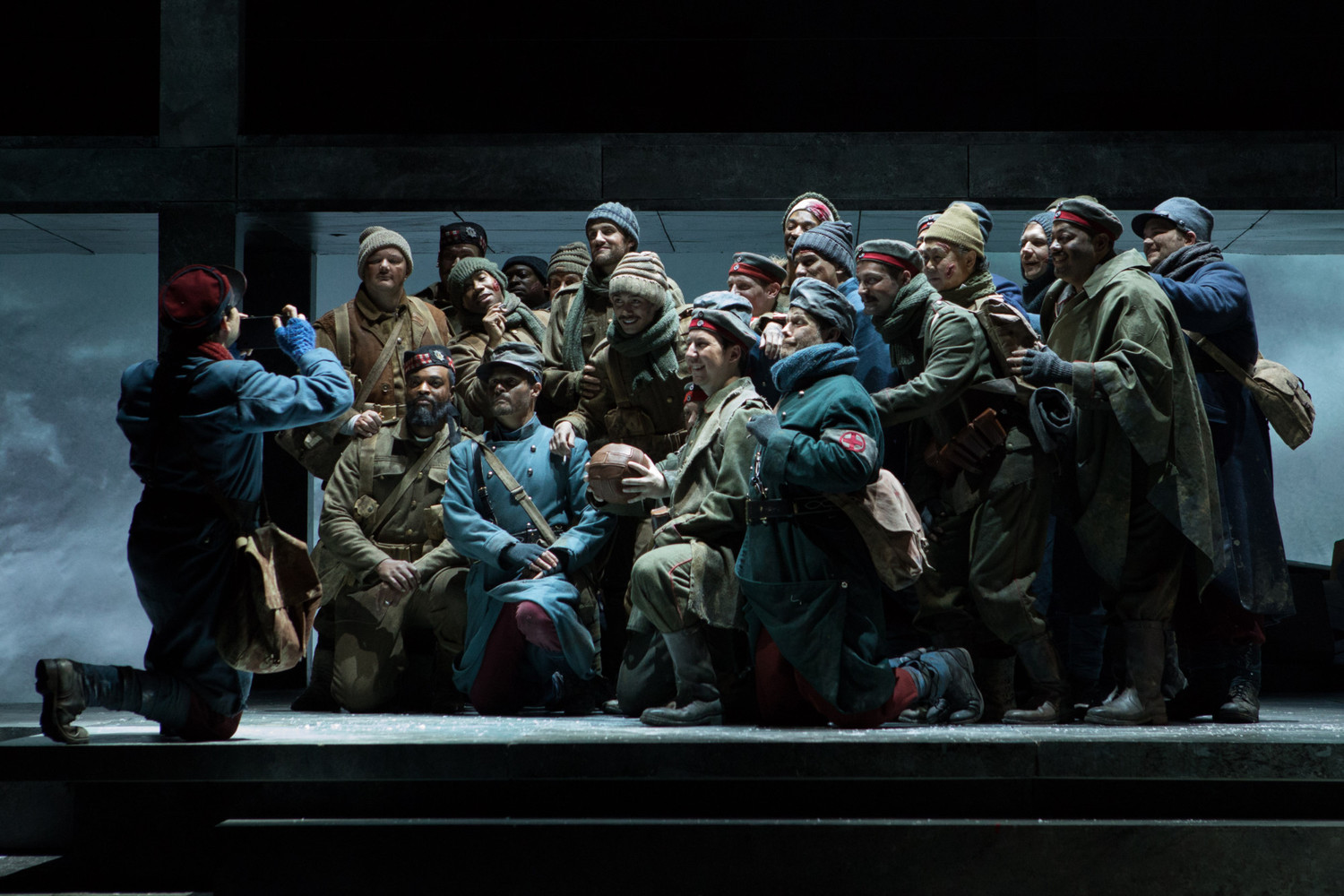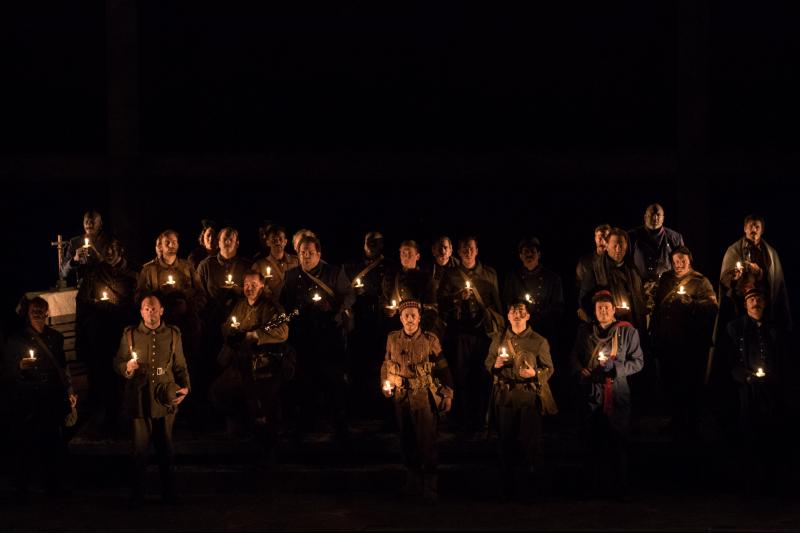Review: Washington National Opera's SILENT NIGHT is a Timely Tribute to Veterans

Photo by Teresa Wood
One hundred years after the armistice of The Great War, it is still crucial to honor the memory of all who fought to create a better world for the future. Washington National Opera's production of Silent Night, which opened on Saturday night at the Kennedy Center, is a glorious celebration of the brave soldiers who have risked their lives for their countries. The production is weakened by some questionable staging choices but serves as a suitable showcase for opera's rising stars.
This 2011 opera chronicles a series of truces that spontaneously took place along several battlefields during World War I in 1914. While on the front lines, the show explores three intersecting storylines, focusing on soldiers for Germany, Scotland, and France. The first plot follows German opera singers Nikolaus Sprink (an incredible Alexander McKissick) and Anna Sørensen (Raquel González), who are divided by the conflict. Scottish brothers Jonathan and William Dale (Arnold Livingston Geis and Hunter Enoch) volunteer for the army in the second story. Finally, French Lieutenant Audebert (Michael Adams), who enlists while his wife is still pregnant with their first child, is the focus of the third story. Sprink's storyline is the only one which is consistently compelling and, while the other two tales have moments of impact, the specifics of their stories fade from memory faster.
%20and%20Anna%20Sorensen%20(Raquel%20Gonzalez)%20refuse%20to%20separate%20in%20WNO's%20Silent%20Night%20production_credit%20Teresa%20Wood.jpg)
Photo by Teresa Wood
The entire ensemble is impressive for this production-especially considering most are still early in their operatic careers. Almost every performer in Silent Night is either a current or recent member of WNO's Domingo-Cafritz Young Artist Program. While this show is clearly built around the entire ensemble, Mr. McKissick and Ms. González run away with the production almost immediately. As the passionate German opera singers, the couple elicits the most amount of sympathy from their stories and lengthy stretches without either of these performers often go on for just a tad too long. It's a shame that the other plot threads of this complex piece miss out on the same emotional heights given the other performers' talents.
Given that this is an opera about war, there is quite a bit of violence at the top of the show. Joe Isenberg, as Fight Master, has done an excellent job of creating the chaos of war. During the initial battle toward the production's beginning, there is so much movement happening that it is difficult to know where exactly one should be looking. Thanks to some skillful work from makeup designer Dave Bova, the aftermath of this action lingers throughout the night with cuts and bruises cleverly created among the entire cast. Add in some strong costuming by Victoria (Vita) Tzykun, and the Eisenhower Theater is filled to the brim with beautiful designs.

Photo by Teresa Wood
Not everything works with Silent Night's production design, however. Compared to the Opera House, the Eisenhower is incredibly small. This becomes particularly apparent thanks to Erhard Rom's set, which often feels too big for the intimate space with which he is working. Three tiers, each housing the camps of a different nation, adorn the large stone facade stretching from the floor to ceiling of the Eisenhower. In addition to a lot of neck-craning, the grand set creates problems with cohesion. Most of the plots feel like separate mini-performances rather than smaller parts of a cohesive work where different threads are woven together. Actors are shoved into small hallways which are barely taller than they are-which has a tendency to stifle much of the action because there just isn't anywhere for them to move.
It is important to note, however, that while the set is not utilitarian it does excel as an extension of this show's honoring of veterans. The facade of the platforms is constructed to represent a World War I memorial and, prior to the production beginning, the names of fallen soldiers scroll across the front scrim.

Photo by Teresa Wood
This scrim, however, is an annoying thorn in the side for much of the evening. From the opera's start, the scrim is down for about fifteen or twenty minutes as each story is set up prior to the war commencing. Coupled with Mr. Rom's projection designs, the scrim creates a barrier between the audience and the performers that makes it incredibly difficult to connect with them until the scrim finally rises after the first large-scale fight of the evening has ended. Even with some solid lighting design by Robert Wierzel, the actors' faces are incredibly hard to see during the opening scenes and there's little that can be done by the performers to create enough emotional investment in their upcoming hardships.
Nicole Paiement serves as an excellent conductor for the evening. Mostly working with new operas, it is a treat to see her revisiting this score. Her development of the orchestra is gorgeous and, from the first notes of the overture, it is clear she has spent extensive time analyzing the Pulitzer Prize-winning music by Kevin Puts and libretto by Mark Campbell. As director, Tomer Zvulun does a good job of keeping the action moving but, given the previously mentioned limitations of the set, there are many moments of connectivity and action that are left under-realized. Even so, there is a clear reverence for the content that shows the amount of care that went into a production beginning performances on such a landmark weekend.
There's a reason why Silent Night is one of the most widely produced contemporary operas. It is surprisingly simple in its emotions yet unbelievably complex in execution (the show features five languages: English, French, German, Italian and Latin). The show isn't a perfectly constructed piece. For instance, the second act only runs about thirty minutes without any major scenic changes, making the decision to include an intermission a little puzzling. Either way, this is a piece that pays homage to the bravery of soldiers from all nations and one that is a fitting way to honor their sacrifices.
Silent Night runs approximately two hours with a 25 minute intermission and plays through November 25 in the Eisenhower Theater at The John F. Kennedy Center for the Performing Arts. For tickets and information click here. For information about the rest of Washington National Opera's offerings, click here.

Sam Abney is a Washington, D.C. based arts professional. A native of Arizona, he has happily made D.C. his new home. Sam is a graduate from George Mason University with a degree in Communication and currently works for Arena Stage as a member of their Development team. He is a life-long lover of theater and is excited about sharing his passion with as many people as possible.
To stay up-to-date on reviews from Sam, click here and subscribe to alerts.
Add Your Comment
Videos

